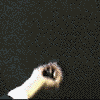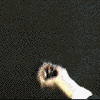Words from Randy
A posting Randy made to SILENCE, the John Cage Mailing list, in July, 1995. (You can visit their archives.):
From: LivingRoo@aol.com
Sender: owner-silence@bga.com
Reply-to: silence@bga.com
To: silence@bga.com
Date: 95-07-02 01:29:23 EDT
Thank you Peter Schmidt for the lovely Rolywholyover tour. I rarely experience things vicariously, but this time was an exception. It did bring back the feeling of attending the exhibit which I did more times than I can remember when it was in Los Angeles. I also liked the mysterious “=8A”s and other hexadecimals sprinkled sparsely amidst at least my copy of your post.
One thing that struck me reading your log is how many of the people who were important to Cage (Duchamp, Thoreau, Satie, Fuller, and many others), for many of whom I developed or renewed my enthusiasm because of Cage, are now important to me in their own right.
Imaginative and careful choice of materials combined with disciplined use of chance operations reveals in this exhibit as in Cage’s music that “nature” is interesting already. When devoting oneself to this kind of work, one trusts that there will be coincidences, and there always are, and they are effective because they are part of the purpose(lessness) of the work, not interfering with it.
I particularly remember Rauschenberg’s tire track piece (created I understand by John driving his Model T while Bob rolled paper out in front of the black paint-covered tire) which always seemed to be echoed by horizontal lines in nearby paintings.
I remember in the glass cases the original souped-up chess board from Reunion. Also a postcard to John and Merce from Alan Ginsberg talking about how there was “No sex!” wherever he was at the time.
>From the Museum of Jurassic Technology in the front room there was a peach pit in which supposedly there was carved very tiny an entire magnificent landscape. But in any case there was no way of telling because the pit was placed way up high on the wall.
And on and on.
I remember going to MOCA once in the past and the guards were the big bummer as they so often are in museums. They were bored and conveyed a stern authoritarian atmosphere. At one point I took out a pen and a guard said I would have to put it away or he would confiscate it.
At this show, the atmosphere was totally different. I remember that there would be a guard stationed over by where the “sleeping” works were stored behind a white line drawn near one end of the main gallery. The guard would take great pleasure in doing his job of telling people not to cross over the line.
There was a terrific panel discussion one day between Merce Cunningham, Allegra Fuller-Snyder, Mark Swed, Marjorie Perloff, and Betty Freeman. Questions were in one container and statements were in another. A question and a statement would be picked randomly, then the panel would comment. Often the statement perfectly answered the question. Later I met Mark Swed and he said he had been working on a Cage biography. Supposedly, Cage wasn’t particularly pleased with any of the biographies that were being written about him (surprise) and he asked Mark Swed rather meekly if he thought he might want to write one. He’s doing it.
Another day I saw a lovely performance by Allison Knowles. Particularly memorable was a piece where she used her coperformer (I forget his name) as a kind of human statue. She gently wrapped him in a variety of beautiful homemade papers (out of beans as I recall). One night I went to hear Janos Negyesy play the Freeman Etudes. I went with a friend. After about an hour she had to go. I gave her a ride home, discovered with her that her roommate’s car battery had been stolen, helped push the car with my car into the garage, met her roommate, and then came back. Negyesy’s virtuostic performance was still going on. I noticed in the audience a person from a spanish class I had recently taken who was the last person I ever would have expected to see there. Walking out of the museum at about 1 a.m. I was greeted by the sound of people loading pipes and lighting instruments into a truck. It sounded exactly like the Freeman Etudes.
Near the closing day of the show, I went to see Vicky Ray, Sandra Brown, Luke Schulze, and Brian Pezzone perform Cage piano music, musicircus style. The performance lasted four hours. About 2 1/2 hours into it, Sandra Brown played the Satie-inspired “Dream”, a piece John dedicated to Merce in 1948. Then about twenty minutes later Brian Pezzone began to play it again. After a few notes Vicki Ray began playing it at the same time, slightly out of phase, and that’s when it all hit me. I looked over to where Julie Lazar was sitting and she was crying too.
Randy Hostetler


